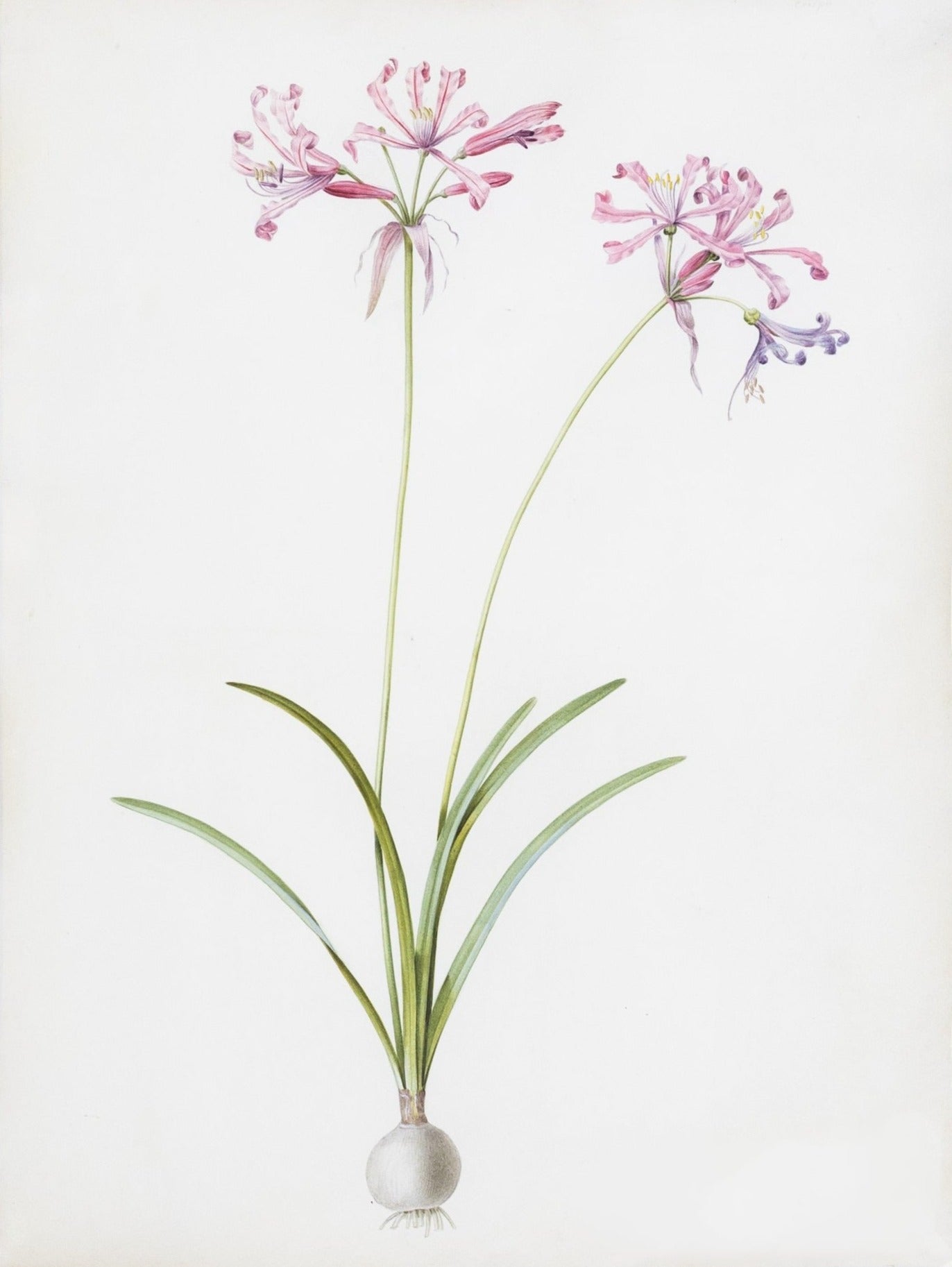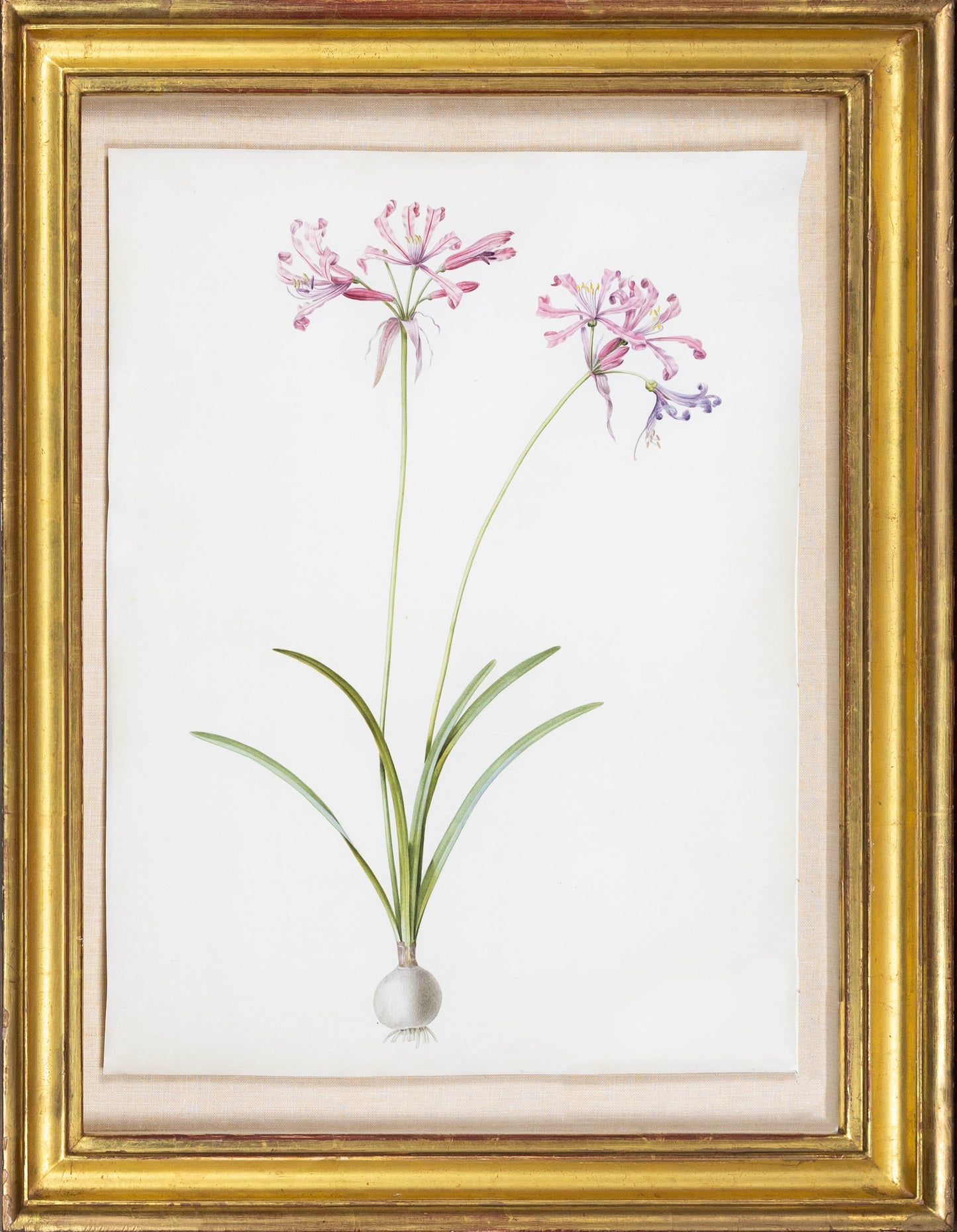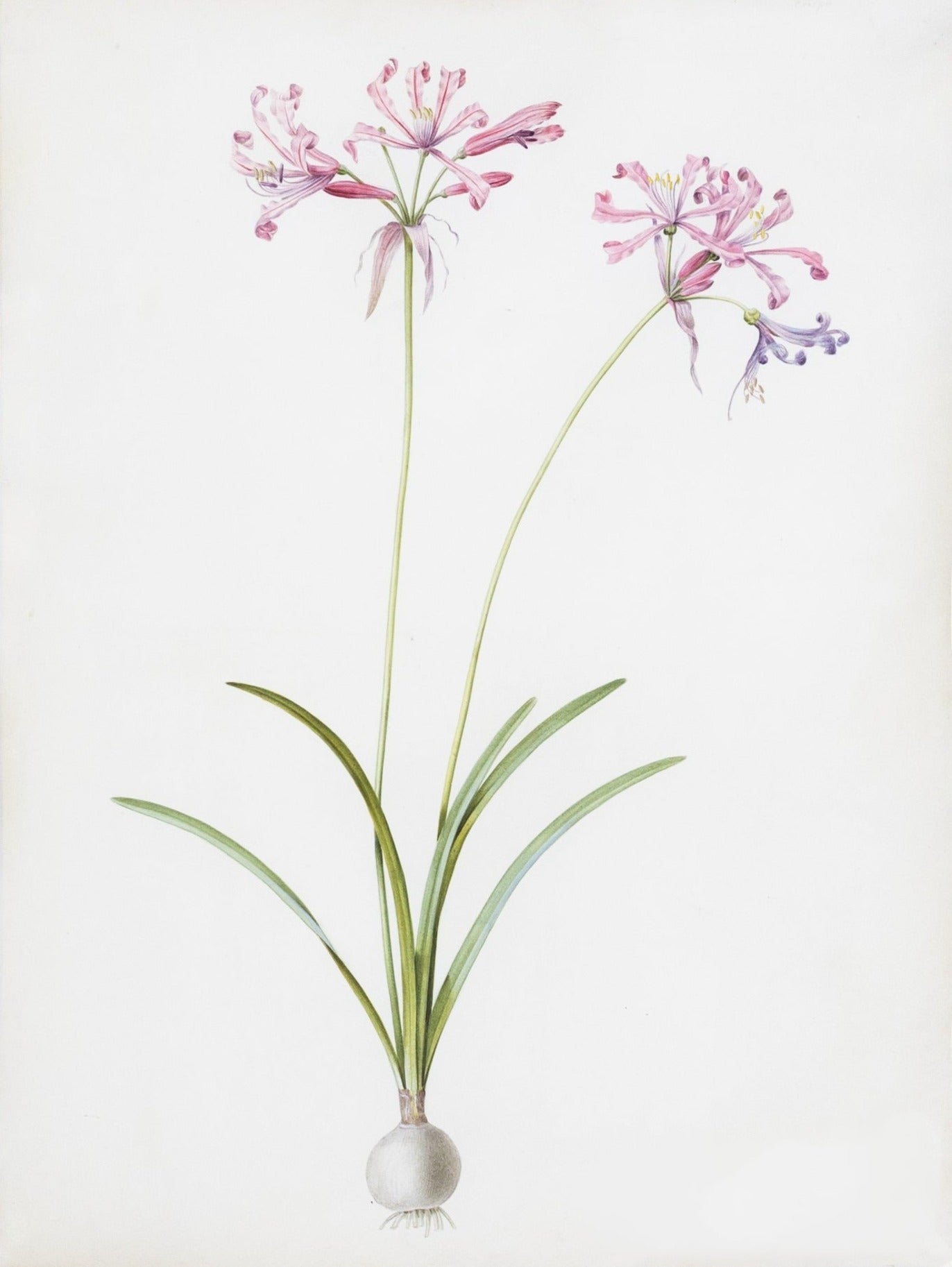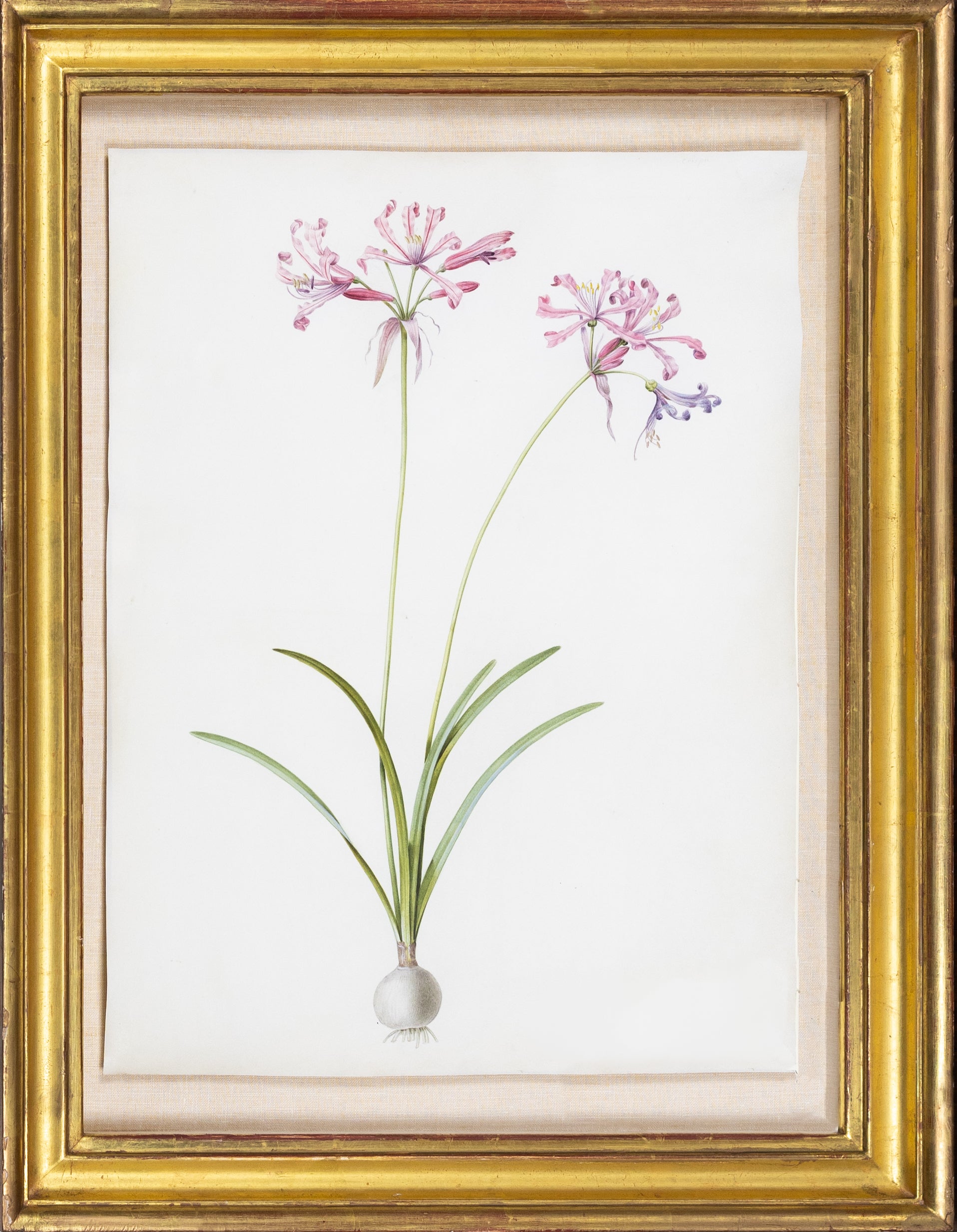Redouté, Pierre-Joseph. "Mountain Lily". Prepared for Les Liliacées, ca. 1802-1816.
Redouté, Pierre-Joseph. "Mountain Lily". Prepared for Les Liliacées, ca. 1802-1816.
Couldn't load pickup availability
Pierre-Joseph Redouté
Watercolor for plate 450: "Mountain Lily" Amaryllis humilis
Prepared for Les Liliacées ca. 1802-1816
Watercolor and graphite on vellum
Signed 'P.J. Redoute' lower left
18 1/2" x 14" vellum, 24 1/2" x 19" framed
Provenance: Acquired from the artist by the Empress Joséphine; Prince Eugène de Beauharnais; by descent through the Dukes of Leuchtenberg; Bibliothèque Eugène de Beauharnais; Braus-Riggenbach and Ulrico Hoepli sale, Zurich, 23 May 1935 (Lot 82); Erhard Wehye; Private trust; Sotheby’s sale, New York, 20 November, 1985; and W. Graham Arader III.
Literature: Peter & Frances Mallary, A Redouté Treasury: 468 Watercolors from Les Liliacées of Pierre-Joseph Redouté, New York, 1986; William P. Watson, “Il Raffaello dei fiori” in KOS (March, 1986), 3:10-23.
In 1798, Joséphine, the wife of Napoleon Bonaparte, acquired the Château de Malmaison at Reuil. An enthusiastic amateur botanist, she surrounded herself with France’s premier horticulturists, such as Jacques-Martin Cels, and created a spectacular botanical garden. Plants were sent from all over the globe with Joséphine’s family in the West Indies, sending her seeds and Napoleon providing seeds and plants from the botanic garden at Schönbrunn Palace in Vienna. The famous botanist, Felix Delahaye, provided many unusual plants for the garden, and Aimé Bonpland also gave advice and supplied the Empress with seeds and plants collected on his expedition to South America from 1799 to 1804. Her affiliations with Kew Gardens in England and associations with the French ambassadors to such exotic places as Morocco, Guiana, and Mexico also proved profitable for Joséphine’s plant collection. In 1805, Joséphine had la grande serre or huge greenhouse erected for the exotic plants she grew and, in addition to the species she was given, by ca. 1807, had spent 2,600 Pounds Sterling on plants from the Kennedy and Lee nursery at Hammersmith (west of London) alone.
Such a collection commanded the employment of a skilled and specialist botanical illustrator, and Joséphine turned to Pierre-Joseph Redouté to record the unique specimens at Malmaison. He supplied 120 plates for Ventenat’s two-volume Jardin de la Malmaison, published between 1803 and 1805, and a further 52 plates for Aimé Bonpland’s 1812 Description des plantes rares cultivées à Malmaison. However, his masterpiece was Les Liliacées, which recorded 486 plants from the gardens at Malmaison. This ambitious task was published in eight folio volumes, taking fourteen years to complete and requiring the assistance of three botanists and eighteen engravers. Some of the watercolors for this landmark work presented here.
The title of Les Liliacées is deceptive as it was a work of much broader scope than merely the Liliaceae family, which accounts for approximately half of the illustrations. What unites all the plant images, and what was of unimaginable importance to botanists, was their inability to be preserved and dried in herbaria. Redoute’s work was the first to provide accurate and detailed drawings of a group of plants that would not otherwise be easily obtainable for study. Redouté’s pencil studies, placed at the bottom of the main illustrations, record the anatomical features of each species so that each flower can be identified with precision and cultivated to perfection. It should be stressed that Redouté was not a botanist. He did not create a written plant description of the main illustrations, record the anatomical features of each species so that each flower can be identified with precision and cultivated to perfection. The accompanying commentary was by noted botanists: Augustin-Pyramus de Candolle, François de la Roche, and Alire Raffenau-Delile. Nevertheless, his watercolors were so detailed that they were invaluable sources of study.
While the published stipple engravings for Les Liliacées are stunning works in their own right, they cannot capture the great and subtle beauty of his original watercolors for Les Liliacées. Redouté created these watercolors as models for the stipple engravings in his landmark work on lilies. However, the delicate and richly colored watercolors have clarity of line and modulation of tone that even the beautiful stipple engravings could not attain. Mostly renowned for his engraved works on paper, only in the watercolors is the full extent of Redouté’s mastery and sensitivity clear.
He chose to work on vellum, a high-quality parchment made from calf’s skin, with a somewhat grainy surface that has to be ‘pounced’ before painting to make it smooth. Vellum must also be stretched on a piece of cardboard while working, for it is susceptible to humidity and creases easily. While more challenging to prepare than paper, its whiteness and its matt appearance gives vellum its reputation and aided Redouté in his manipulation of light and shade to provide such volume and immediacy to the plants that they seem to bloom right before our eyes. Moreover, he makes full use of the whiteness of the vellum material to create classical “portraits,” which lack backgrounds or settings, the majestic simplicity of the compositions allowing the viewer to focus without distraction on the beauty and delicate complexity of the plants themselves.
What remains remarkable about Redouté’s watercolors for Les Liliacées is that they have remained clean and fresh, particularly when it is considered that they were used as models by the engravers and the colorists. Extra care was likely taken because their ultimate destination was the collection of the Empress Joséphine. It is also probable that the mirror system used by the engraver to transfer the image also aided in their salvation from exposure to dirty thumbprints or paint splashes. Unlike other engraved publications that show the artist’s original studies in reverse, Redouté insisted that each plant represent precisely what was observed. Thus, the engraver’s studio was equipped with an elaborate system of mirrors, to permit each craftsman to view the artist’s drawing in reverse. The technique had the added advantage of separating the vellum from continuous workshop handling.




